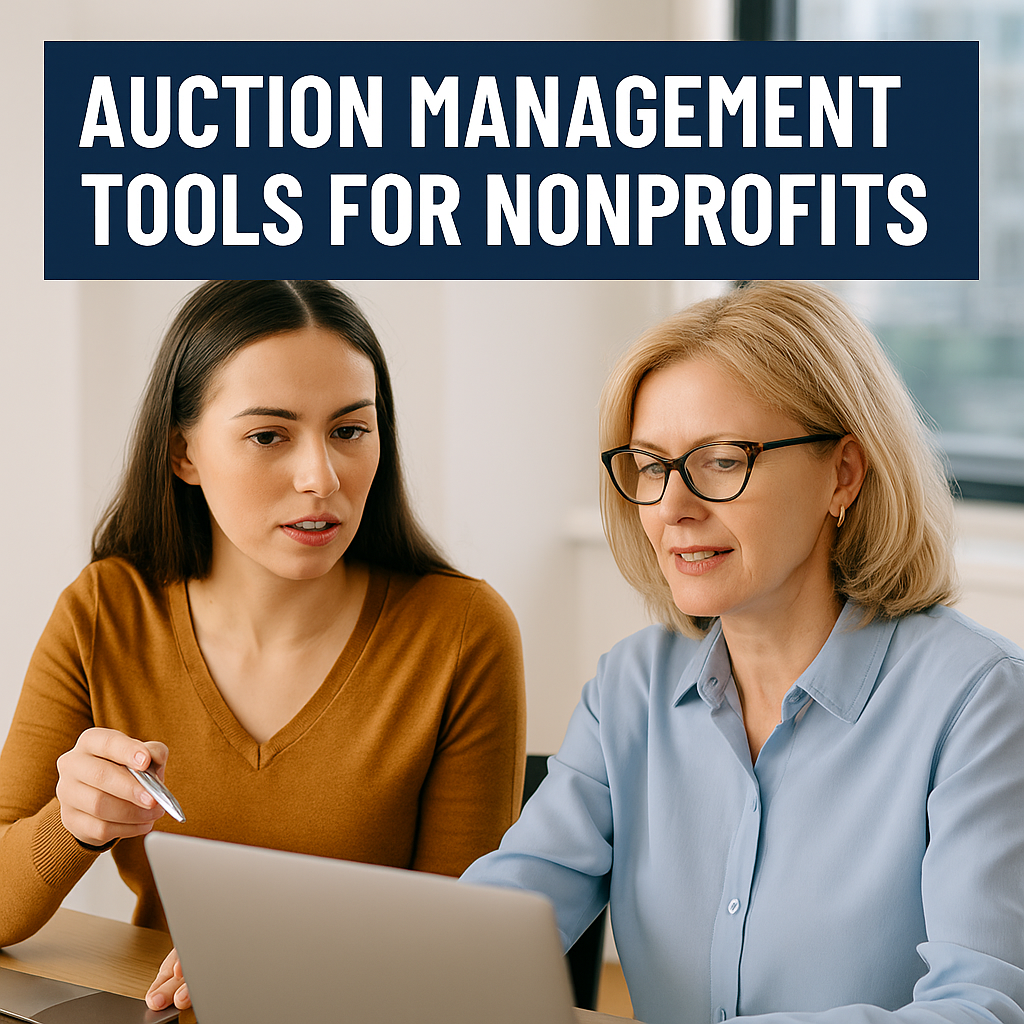Why Auction Management Tools Matter
Running a charity auction is one of the most effective ways to raise funds — but it’s also one of the most time-consuming. Between item tracking, bidder registration, check-in, check-out, receipts, and post-event reporting, staff hours add up fast.
Modern auction software solves this by automating nearly every step of the process — freeing teams to focus on donor relationships and storytelling instead of spreadsheets and manual tasks.
What Tools Help Nonprofits Save Time?
The best auction management tools combine automation, mobile bidding, real-time reporting, and integrated payment processing to streamline operations.
Top options include:
| Platform | Best For | Key Time-Saving Features |
|---|---|---|
| CharityAuctionsToday | Easiest all-in-one auction platform | Fast setup, mobile bidding, automatic receipts, real-time reporting |
| Auctria | Budget-friendly events | Item import templates, bidder text alerts, donation tracking |
| OneCause | Large galas and hybrid events | Integrated CRM, ticketing, check-in/out automation |
| GiveSmart | Enterprise-level organizations | Sponsorship management, guest communication, analytics |
| Silent Auction Pro | Mid-sized nonprofits | Item bundling, volunteer task management, simple reporting |
Features That Save the Most Time
1. Automated Setup & Item Cataloging
Most modern auction tools import items from spreadsheets or donor forms instantly. Pre-built templates eliminate repetitive data entry.
2. Mobile Bidding & Notifications
Mobile bidding tools like CharityAuctionsToday let guests bid, pay, and check out from their phones — reducing event-day staffing needs by up to 60%.
3. CRM & Donor Database Integration
Platforms that sync with CRMs or donor tools (like Salesforce or Bloomerang) automate post-event communication and reporting.
4. Payment & Invoicing Automation
Instant invoicing and auto-receipts reduce manual reconciliation and eliminate hours of accounting follow-up.
5. Real-Time Analytics Dashboards
Instant insights into bids, revenue, and donor participation help staff adjust strategies mid-event — no manual tallying required.
Implementation Tips to Maximize Efficiency
- Start early: Import donor lists and items at least a week before launch.
- Use templates: Customize auction page and email templates once, then reuse them.
- Automate reminders: Send automatic “outbid” and “closing soon” messages.
- Leverage reports: Export performance data right after closing for board reports or grant applications.
- Train volunteers: One short training session drastically reduces event-day stress.
Real-World Example
A small Midwest animal rescue ran its annual gala with just two staff members using CharityAuctions. By using automated bidder registration, QR-code check-in, and instant receipting, they saved over 40 staff hours compared to their previous year’s manual system — and increased net proceeds by 25%.
Key Takeaway
Auction management tools aren’t just “nice to have” — they’re essential time-savers for busy nonprofit teams.
By investing in automation, you gain back valuable hours that can be redirected toward donor relationships, storytelling, and impact.
Related Reading
Frequently Asked Questions
What are auction management tools for nonprofits?
Auction management tools are software features that streamline planning, promotion, bidding, payments, and post-event wrap-up. The goal is to reduce manual work, prevent errors, and free staff to focus on donors and mission.
Which features save staff the most time overall?
- Bulk item intake and catalog publishing.
- Mobile check-in/out with QR codes.
- Automated receipts, reminders, and outbid alerts.
- Integrated payments and CRM sync.
- Real-time reporting and exports.
How do we quickly choose and set up tools for our auction?
- List top goals (revenue, guest experience, staff hours saved).
- Map must-have features (check-in, mobile bidding, receipts, CRM).
- Import a test guest list and 10 items; run a sandbox mini-auction.
- Enable payments, taxes/fees, and templates; rehearse run-of-show.
What’s a simple timeline to implement auction tools?
- 6–8 weeks out: select platform, set goals, brand pages.
- 4–6 weeks: load items, secure sponsors, open tickets.
- 2–3 weeks: train volunteers, test check-in, schedule comms.
- Event week: finalize seating, dry-run check-out, print backup QR codes.
Which KPIs show our tools are working effectively?
- Average check-in time and line length.
- % of items with bids; bids per item; sell-through rate.
- Outbid alert open/click rate; bidder conversion.
- Check-out time per guest; payment success rate.
- Data sync completeness (contacts, gifts, soft credits).
How do item intake tools reduce admin time and errors?
Use donor-facing procurement forms, bulk CSV import, image auto-resize, and category templates. Require fair-market value, restrictions, and expiration dates to be captured at submission to avoid back-and-forth later.
What registration features speed guest entry on event day?
- Digital tickets with unique QR codes.
- Pre-event card-on-file and e-waivers.
- Self-check-in kiosks and alphabetized search.
- Table/seat assignments visible on mobile.
How do mobile bidding and reminders increase participation?
Real-time outbid alerts, watchlists, and countdowns keep guests engaged without micromanagement. Auto-bid (proxy) and max-bid features raise final prices while minimizing staff intervention.
What payment and receipt tools shorten check-out lines?
Card-on-file with one-tap settlement, split payments, instant email receipts, and automatic tax-deductible summaries reduce bottlenecks. General information, not legal/tax/financial advice.
Why do CRM and accounting integrations matter for staff time?
Automatic contact, gift, and pledge sync eliminates duplicate entry and mismatched totals. Map fields (campaign, fund, appeal, soft credits) once, then export reconciled batches in minutes.
How can tools simplify volunteer management on event day?
- Role-based permissions for check-in, catalog edits, and settlement.
- Task lists with shift times and mobile instructions.
- Issue tracking (lost items, payment questions) with quick notes.
What reporting features should we insist on?
- Real-time totals and leaderboards by item, category, donor, bidder.
- Settlement reports with fees, tips, and refunds.
- Exportable audit trails for finance and board reporting.
Any tips for fulfillment so staff aren’t stuck for days after?
Triage by pickup vs. ship, capture shipping preferences at payment, pre-print item claim slips, and batch label printing. For experiences, store contact details and redemption windows directly in winner receipts.
Do you have a quick donor procurement email script we can use?
Template: “Hi [Name]—we’re raising funds for [impact]. Would you consider donating [item idea] by [date]? We’ll feature your business in our catalog and event signage. Reply with details and we’ll send a quick intake link. Thank you!”
What data hygiene steps prevent headaches later on?
- Standardize name, email, phone formats before import.
- Use unique IDs for guests, donors, items, and bidders.
- Document custom fields and sync rules in a one-page SOP.
Which accessibility features should we enable by default?
- Large text and high-contrast display options.
- Language toggles and alt text for images.
- Clear plain-language bidding and payment instructions.
How should we handle taxes, fees, and compliance settings?
Configure sales tax where applicable, enable fee coverage options, and produce donor receipts that separate goods vs. tax-deductible amounts. Confirm with your accountant or counsel. General information, not legal/tax/financial advice.
What hybrid/online workflows minimize staff workload?
Open bidding online early, close premium items live, and leave long-tail items open post-event. Use scheduled messages, auto-extend features, and digital receipts so staff aren’t tied to manual updates.
What common pitfalls slow teams down—and how do we avoid them?
- Over-customizing pages—use brand templates.
- Late item intake—set weekly intake cutoffs.
- Untrained volunteers—host a 30-minute rehearsal with checklists.
- No backup plan—print QR sheets and bring hotspot devices.
How do tools help with post-event follow-up and retention?
Use automated thank-you emails with impact stories, pledge reminders, and a one-click monthly gift option. Template: “Your bid funded [outcome]. Want to keep it going monthly at $[amount]?” General information, not legal/tax/financial advice.
💡 Try this in ChatGPT
- Summarize the article "Which Auction Management Tools Help Save Time for Nonprofit Staff" from https://blog.charityauctions.com/auction-management-tools-nonprofits/ in 3 bullet points for a board update.
- Turn the article "Which Auction Management Tools Help Save Time for Nonprofit Staff" (https://blog.charityauctions.com/auction-management-tools-nonprofits/) into a 60-second talking script with one example and one CTA.
- Extract 5 SEO keywords and 3 internal link ideas from "Which Auction Management Tools Help Save Time for Nonprofit Staff": https://blog.charityauctions.com/auction-management-tools-nonprofits/.
- Create 3 tweet ideas and a LinkedIn post that expand on this help topic using the article at https://blog.charityauctions.com/auction-management-tools-nonprofits/.
Tip: Paste the whole prompt (with the URL) so the AI can fetch context.
Share this article
Tom Kelly, TEDx speaker and CEO of CharityAuctions.com, helps nonprofits raise millions through auctions and AI. He hosts The Million Dollar Nonprofit podcast and inspires leaders to live their legacy, not just leave it.
Table of contents
Create Your Auction
Raise 40% more with smart bidding tools


